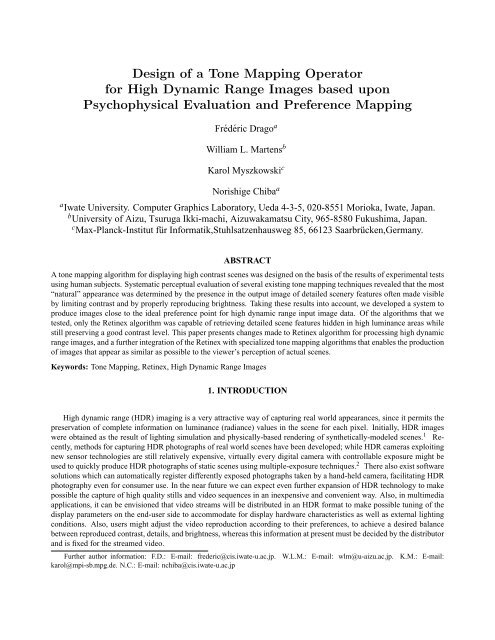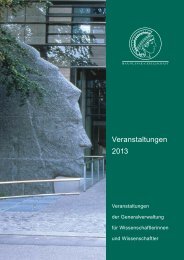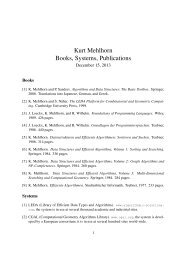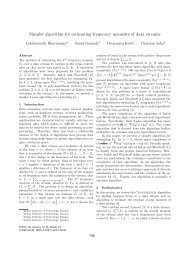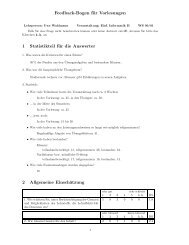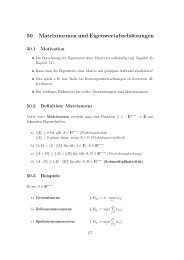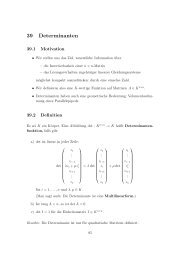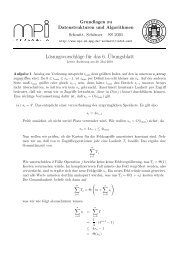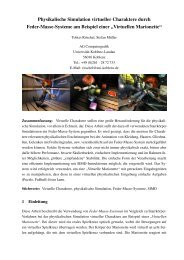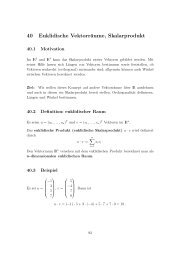Design of a Tone Mapping Operator for High Dynamic Range ...
Design of a Tone Mapping Operator for High Dynamic Range ...
Design of a Tone Mapping Operator for High Dynamic Range ...
You also want an ePaper? Increase the reach of your titles
YUMPU automatically turns print PDFs into web optimized ePapers that Google loves.
<strong>Design</strong> <strong>of</strong> a <strong>Tone</strong> <strong>Mapping</strong> <strong>Operator</strong><br />
<strong>for</strong> <strong>High</strong> <strong>Dynamic</strong> <strong>Range</strong> Images based upon<br />
Psychophysical Evaluation and Preference <strong>Mapping</strong><br />
Frédéric Drago a<br />
William L. Martens b<br />
Karol Myszkowski c<br />
Norishige Chiba a<br />
a Iwate University. Computer Graphics Laboratory, Ueda 4-3-5, 020-8551 Morioka, Iwate, Japan.<br />
b University <strong>of</strong> Aizu, Tsuruga Ikki-machi, Aizuwakamatsu City, 965-8580 Fukushima, Japan.<br />
c Max-Planck-Institut für In<strong>for</strong>matik,Stuhlsatzenhausweg 85, 66123 Saarbrücken,Germany.<br />
ABSTRACT<br />
A tone mapping algorithm <strong>for</strong> displaying high contrast scenes was designed on the basis <strong>of</strong> the results <strong>of</strong> experimental tests<br />
using human subjects. Systematic perceptual evaluation <strong>of</strong> several existing tone mapping techniques revealed that the most<br />
“natural” appearance was determined by the presence in the output image <strong>of</strong> detailed scenery features <strong>of</strong>ten made visible<br />
by limiting contrast and by properly reproducing brightness. Taking these results into account, we developed a system to<br />
produce images close to the ideal preference point <strong>for</strong> high dynamic range input image data. Of the algorithms that we<br />
tested, only the Retinex algorithm was capable <strong>of</strong> retrieving detailed scene features hidden in high luminance areas while<br />
still preserving a good contrast level. This paper presents changes made to Retinex algorithm <strong>for</strong> processing high dynamic<br />
range images, and a further integration <strong>of</strong> the Retinex with specialized tone mapping algorithms that enables the production<br />
<strong>of</strong> images that appear as similar as possible to the viewer’s perception <strong>of</strong> actual scenes.<br />
Keywords: <strong>Tone</strong> <strong>Mapping</strong>, Retinex, <strong>High</strong> <strong>Dynamic</strong> <strong>Range</strong> Images<br />
1. INTRODUCTION<br />
<strong>High</strong> dynamic range (HDR) imaging is a very attractive way <strong>of</strong> capturing real world appearances, since it permits the<br />
preservation <strong>of</strong> complete in<strong>for</strong>mation on luminance (radiance) values in the scene <strong>for</strong> each pixel. Initially, HDR images<br />
were obtained as the result <strong>of</strong> lighting simulation and physically-based rendering <strong>of</strong> synthetically-modeled scenes. 1 Recently,<br />
methods <strong>for</strong> capturing HDR photographs <strong>of</strong> real world scenes have been developed; while HDR cameras exploiting<br />
new sensor technologies are still relatively expensive, virtually every digital camera with controllable exposure might be<br />
used to quickly produce HDR photographs <strong>of</strong> static scenes using multiple-exposure techniques. 2 There also exist s<strong>of</strong>tware<br />
solutions which can automatically register differently exposed photographs taken by a hand-held camera, facilitating HDR<br />
photography even <strong>for</strong> consumer use. In the near future we can expect even further expansion <strong>of</strong> HDR technology to make<br />
possible the capture <strong>of</strong> high quality stills and video sequences in an inexpensive and convenient way. Also, in multimedia<br />
applications, it can be envisioned that video streams will be distributed in an HDR <strong>for</strong>mat to make possible tuning <strong>of</strong> the<br />
display parameters on the end-user side to accommodate <strong>for</strong> display hardware characteristics as well as external lighting<br />
conditions. Also, users might adjust the video reproduction according to their preferences, to achieve a desired balance<br />
between reproduced contrast, details, and brightness, whereas this in<strong>for</strong>mation at present must be decided by the distributor<br />
and is fixed <strong>for</strong> the streamed video.<br />
Further author in<strong>for</strong>mation: F.D.: E-mail: frederic@cis.iwate-u.ac.jp. W.L.M.: E-mail: wlm@u-aizu.ac.jp. K.M.: E-mail:<br />
karol@mpi-sb.mpg.de. N.C.: E-mail: nchiba@cis.iwate-u.ac.jp
While the prospects <strong>for</strong> proliferation <strong>of</strong> HDR capturing technologies are good, an important problem to solve regards<br />
how to reproduce the precise in<strong>for</strong>mation <strong>for</strong> scene appearance using media with very limited dynamic range such as hardcopy<br />
prints, CRT displays, and projectors. While there are some ef<strong>for</strong>ts made to build high dynamic range display devices,<br />
they deal mostly with static images, and are expensive and laborious to use. 3 To solve the problem <strong>of</strong> trans<strong>for</strong>ming high<br />
dynamic range images to the limited range <strong>of</strong> most exiting devices, so-called tone mapping operators are being developed.<br />
The goals <strong>of</strong> tone mapping can be differently stated depending on the particular application. In some cases producing<br />
just “nice-looking” images is the main goal, while other applications might emphasize reproducing as many image details<br />
as possible, or might maximize the image contrast. The goal in realistic rendering applications might be to obtain a<br />
perceptual match between a real scene and and a displayed image even though the display device is not able to reproduce<br />
the full range <strong>of</strong> luminance values. 4 However, achieving such a match is feasible because the visual system <strong>of</strong> humans<br />
has limited capacity to detect differences in absolute luminance levels, and concentrates more on aspects <strong>of</strong> spatial patterns<br />
when comparing two images. 5<br />
Many tone mapping operators that appeared in the last decade have been designed to specifically address some <strong>of</strong><br />
the issues discussed here. The goal <strong>of</strong> this work is to develop a general purpose tone mapping technique which leads to<br />
“natural” looking images. The design <strong>of</strong> our technique is based on perceptual evaluation <strong>of</strong> several existing tone mapping<br />
techniques. Our prior study revealed that “natural” appearance was determined by the presence in the output image <strong>of</strong><br />
detailed scenery features <strong>of</strong>ten made visible by limiting contrast and by properly reproducing brightness. 6 Taking these<br />
results into account, we developed a tone mapping operator based on the Retinex algorithm 7–9 to enhance details in very<br />
high illumination areas <strong>of</strong> a scene, coupled with an adaptive tone mapping function, to reproduce the lighting conditions<br />
<strong>of</strong> the scene.<br />
In Section 2 we discuss previous work on tone mapping techniques, which have been developed mostly <strong>for</strong> computer<br />
graphics applications. Then, in Section 3 we summarize the results obtained in our psychophysical experiments 6 which had<br />
as their goal the evaluation <strong>of</strong> six popular tone mapping algorithms. In Section 4 we provide some background in<strong>for</strong>mation<br />
on Retinex which is the main focus in this work. Our extensions <strong>of</strong> Retinex to accommodate <strong>for</strong> HDR images are presented<br />
in Section 5. In Section 6 is a discussion <strong>of</strong> the further computations necessary to convert an image processed by Retinex<br />
into an image that should be preferred according to perceptual criteria. Finally we conclude this work and suggest some<br />
directions <strong>for</strong> future research.<br />
2. PREVIOUS WORK ON TONE MAPPING OPERATOR<br />
Although the tone mapping problem is still not well studied, a number <strong>of</strong> surveys summarizing the state-<strong>of</strong>-the-art solutions<br />
have been recently published. 10–13 In general, tone mapping can be classified as time dependent <strong>for</strong> handling animated<br />
sequences and time independent designed specifically <strong>for</strong> static images. In this work we deal exclusively with the latter<br />
category.<br />
Another classification takes into account whether the same mapping function is used <strong>for</strong> all pixels (spatially uni<strong>for</strong>m<br />
or global operators) or if the mapping function variates depending on a given pixel neighborhood which is <strong>of</strong>ten achieved<br />
through the modeling <strong>of</strong> spatial adaptation (spatially varying or local operators).<br />
Yet another classification takes into account whether a given tone mapping algorithm tries to model some characteristics<br />
<strong>of</strong> the Human Visual System or perhaps is a pure image processing technique which essentially trans<strong>for</strong>ms one image into<br />
another.<br />
One <strong>of</strong> the best known global and perception-motivated operator was proposed by Tumblin and Rushmeier. 14 It is<br />
based on the idea <strong>of</strong> brightness preservation in order to get matching between the view <strong>of</strong> real and displayed scenes. The<br />
relation between scene/display luminance and perceived brightness is modeled using a psychophysical model <strong>of</strong> brightness<br />
perception developed by Stevens and Stevens. 15 More recently Tumblin and Rushmeier proposed a revised method,<br />
which improves the per<strong>for</strong>mance <strong>of</strong> the original <strong>for</strong> scotopic viewing conditions. 16 To the same category can be included<br />
operators developed by Ward 17 and Ferwerda et al. 18 which emphasize on preserving the perceived contrast. The Visual<br />
Adjustment operator proposed by Ferwerda et al. models also the eye sensitivity and color appearance <strong>for</strong> photopic,<br />
mesopic, and scotopic viewing conditions. The method is very efficient in terms <strong>of</strong> computation because it boils down<br />
to a linear scaling coefficient, but this means that its compressive power is somewhat limited. Ward et al. 19 proposed the<br />
Histogram Adjustment technique which allocates dynamic range space in proportion to the percentage <strong>of</strong> pixels with similar<br />
brightness. This means that the brightness levels which are poorly represented in the image are strongly compressed, while
pixels featuring even small differences in brightness but well represented in the image can obtain significant portion <strong>of</strong> the<br />
available dynamic range. As a result the mapping function may have a complicated shape but remains monotonic. It is<br />
applied globally to all pixels and results in high contrast images. Local contrast can be additionally modified by glare and<br />
visual acuity modeling.<br />
An example <strong>of</strong> global method which relies purely on image processing without considering perception is the Uni<strong>for</strong>m<br />
Scaling Quantization method proposed by Schlick. 20 He uses rational functions which are efficient to compute, have<br />
controllable shape, and when required may compress luminance strongly.<br />
Methods based on local image contents proved to be more efficient in high dynamic range compression, because<br />
<strong>of</strong> considering the neighborhood <strong>of</strong> each pixel be<strong>for</strong>e applying locally customized compressive function. Early local<br />
methods 21, 22 lead to inverse gradients and halo effects at the proximity <strong>of</strong> high luminance gradients. The same problems<br />
occur <strong>for</strong> another local method Retinex. 8, 23 We discuss it in detail in Section 4 and apply solutions to avoid those image<br />
artifacts. The Low Curvature Image Simplifier method proposed by Tumblin and Turk 24 is not affected by halos, and<br />
represents well high frequency details, however, it is slow in terms <strong>of</strong> computation and <strong>of</strong>ten leads to images with an<br />
excessively low contrast.<br />
In 2002, a number <strong>of</strong> successful local methods have been proposed which avoid the typical problems <strong>of</strong> their predecessors.<br />
Reinhard et al. proposed the Photographic <strong>Tone</strong> Reproduction, 25 which is inspired by “dodging and burning”<br />
used in photography and makes possible local contrast adjustment. A recent version <strong>of</strong> this method operates automatically<br />
freeing the user from setting parameters that are not particularly intuitive. 26 Ashikhmin 27 proposes a perception-motivated<br />
algorithm which uses local adaptation level <strong>for</strong> each pixel to decide upon the non-linear compression applied to the luminance<br />
<strong>of</strong> the pixel. Since this suppresses high frequency details in the image, those details must be re-introduced at a final<br />
step. Fattal et al. 28 proposed an image processing method which identifies gradients at various scales and attenuates more<br />
strongly drastic luminance changes, while preserving smaller changes which are responsible <strong>for</strong> high frequency details<br />
in the image. A multi-scale decomposition based on the Gaussian pyramid approach is applied to separate low frequency<br />
details (to be strongly compressed) from high frequency details (to be even slightly amplified). Although the gradient attenuation<br />
function is computed <strong>for</strong> each pyramid level separately the actual scaling is per<strong>for</strong>med at the finer image resolution<br />
to avoid halo artifacts. Durand and Dorsey 29 also decompose image, but they consider only two different spatial frequency<br />
layers: base and detail. For the decomposition they use a non-linear, edge preserving filter. They suppress high contrast<br />
in the base layer and combine it with the detail layer which essentially remains unchanged. All four recent methods are<br />
efficient in terms <strong>of</strong> computations and lead to nicely looking images.<br />
The problem <strong>of</strong> color reproduction on the limited gamut <strong>of</strong> a display device has attracted much less attention in computer<br />
graphics. However, it is well addressed in the more specialized literature <strong>of</strong> imaging and color science. An example<br />
<strong>of</strong> an advanced color reproduction model, which predicts a wide range <strong>of</strong> visual phenomena, is the Hunt model 30 developed<br />
in the Kodak Research Laboratories. A comprehensive survey <strong>of</strong> the color appearance models can be found in. 31<br />
3. PERCEPTUAL EXPERIMENTS<br />
As we discussed in the previous section the problem <strong>of</strong> mapping full range luminance data into the limited luminance range<br />
<strong>of</strong> display devices has been addressed through the development <strong>of</strong> many different tone mapping algorithms, but evaluating<br />
the success <strong>of</strong> these solutions is rather complex. It is in fact quite difficult to judge whether putative improvements in<br />
existing algorithms actually produce images that would be preferred to those produced by the algorithms be<strong>for</strong>e their<br />
“improvement.” Changes should be made to achieve specific, well-defined goals. One such goal might be to obtain images<br />
that look as “good” as possible and are always preferred by the most viewers. In this work we focus specifically on the<br />
goal <strong>of</strong> faithful reproduction <strong>of</strong> real world appearance, which we have termed “naturalness.”<br />
Our approach to the design <strong>of</strong> a tone mapping algorithm to display HDR images is based upon both psychophysical<br />
evaluation and preference mapping. In order to best generalize the results <strong>of</strong> this evaluation, a number <strong>of</strong> synthetic images<br />
and photographs were processed using six popular tone mapping operators: Photographic <strong>Tone</strong> Reproduction (P), 25<br />
Uni<strong>for</strong>m Scaling Quantization (Q), 20 Retinex (X), 8, 23 Visual Adjustment (V), 18 Revised Tumblin-Rushmeier (T),<br />
and Histogram Adjustment (H), 19 which we briefly characterize in Section 2. In a preliminary, exploratory stage <strong>of</strong> this<br />
study, global dissimilarity judgments were made <strong>for</strong> all pairwise comparisons <strong>of</strong> the resulting images, and these judgments<br />
were submitted to INdividual Differences SCALing (INDSCAL) analysis. Then, in order to aid in the interpretation <strong>of</strong><br />
the INDSCAL results, psychophysical scale values were obtained <strong>for</strong> the same images with respect to three perceptual<br />
11, 14
attributes: apparent contrast, level <strong>of</strong> detail, and naturalness. Multiple regression analysis revealed than the first perceptual<br />
dimension describing the differences between stimuli was associated linearly with apparent level <strong>of</strong> detail (r = .85), and<br />
the second INDSCAL-derived dimension was most highly associated with apparent naturalness (r = .67). A more complex<br />
relationship was found <strong>for</strong> apparent contrast, the fit regression equation having significant quadratic components on both<br />
dimensions <strong>of</strong> the INDSCAL-derived “Stimulus Space.”<br />
Next, the stimuli were ordered with respect to viewer preference via pairwise <strong>for</strong>ced-choice comparisons, and the resulting<br />
ordinally-scaled preference values were submitted to PREFerence MAPping (PREFMAP) analysis. This analysis<br />
related preference values to stimulus coordinates on the INDSCAL-derived dimensions. The results identified an ideal<br />
preference point in INDSCAL-derived “Stimulus Space,” the location <strong>of</strong> which suggested that the ideal tone mapping operator<br />
should produce higher-than-average detail, but slightly lower-than-average naturalness (with respect to the stimuli<br />
examined). Furthermore, higher contrast images were not preferred nor regarded as more natural; rather, a moderate contrast<br />
coupled with relatively higher detail (in geometry and textures) was most preferred. In addition, several unacceptable<br />
artifacts were identified, including improper reproduction <strong>of</strong> overall brightness, cropped luminance around light sources,<br />
and loss <strong>of</strong> detail in the images darker regions.<br />
More details on this research can be found in our report. 6 For the reader’s convenience we include Figure 1 which<br />
summarizes the obtained results presented in that report.<br />
Naturalness (r=.67)<br />
2<br />
1<br />
0.5<br />
0<br />
−0.5<br />
−1<br />
−1.5<br />
V<br />
T<br />
H<br />
−2<br />
−2 −1 0 1 2<br />
Detail (r=.85)<br />
Figure 1. The 2D “group” Stimulus Space solution based upon INDSCAL analysis <strong>of</strong> dissimilarity ratings <strong>for</strong> six tone mapper applied to<br />
four scenes (24 images total). The letter in each circular symbol identifies the tone mapper applied: Revised Tumblin and Rushmeier<br />
(T), Photographic <strong>Tone</strong> Reproduction (P), Uni<strong>for</strong>m Rational Quantization (Q), Histogram Adjustment (H), RetineX (X), and Visual<br />
Adaptation (V). The concentric circles correspond to iso-contrast contours, and the diamond symbols plots the “ideal” preference point<br />
that resulted from PREFMAP ideal-point unfolding. The x axis <strong>of</strong> the graph is labeled “Detail” because the coordinates on this dimension<br />
correlated most highly with obtained “detail” ratings. The y axis <strong>of</strong> the graph is labeled “Naturalness” by the same rationale.<br />
The subsequent research reported here is based upon these results, but is mostly focused on an attempt to extend the<br />
Retinex algorithm to handle HDR images and produce naturally looking images. Essentially we use Retinex to extract the<br />
detailed features <strong>of</strong> the scene, and then follow this with a global tone mapping function to further restore the brightness<br />
and adapt the final image to the displaying method. We describe all the involved steps in detail in the following sections.<br />
However, be<strong>for</strong>e moving on to the description <strong>of</strong> the extensions, we provide some background in<strong>for</strong>mation on standard<br />
Retinex algorithms.<br />
ideal<br />
point<br />
4. RETINEX BACKGROUND<br />
The Retinex theory <strong>of</strong> human vision presented by Edwin Land 7 was designed to explain perceptual phenomena, and as<br />
such seems an ideal basis <strong>for</strong> a computational method to predict human adaptation to light intensity. Lightness transfer<br />
among pixels in a scene has already been applied. 21, 22 In an ef<strong>for</strong>t to solve the tone mapping problem Jobson et al. 9<br />
Q<br />
X<br />
P
implemented a Retinex variation based on a Gaussian center-surround function to simultaneously achieve dynamic range<br />
compression, color constancy, and lightness rendition. The efficiency <strong>of</strong> their approach was proven with medium contrast<br />
24-bit images, but high dynamic content caused some artifacts.<br />
Although the principle and basic processing steps were always similar to the first implementation by Land and Mc-<br />
Cann, 7 many variations <strong>of</strong> Retinex have been proposed, mainly differing in the choice and randomness <strong>of</strong> path in the image<br />
plane along which processed pixels are selected. For example Marini et al. 32 implemented an approximation <strong>of</strong> Brownian<br />
motion to generate random paths.<br />
We adapted the Retinex variation proposed by Frankle and McCann8 and later implemented by Funt et al. 23 This<br />
iterative scheme is based on interactions between luminance values <strong>for</strong> pairs <strong>of</strong> pixels whose image plane coordinates are<br />
denoted as (x,y) and (xs,ys). The number <strong>of</strong> Retinex iterations at each step <strong>of</strong> the calculation is decided by the user. The<br />
first step processes pixels horizontally separated by a predefined distance D, then the direction <strong>for</strong> comparison is rotated<br />
90° the computation is repeated a number <strong>of</strong> time. The distance D is halved at each step until unit pixel distance is reached.<br />
In each iteration the ratio <strong>of</strong> luminance values R(x,y) and R(xs,ys) in the original image is multiplied by the luminance<br />
value OP(xs,ys) computed <strong>for</strong> the previous Retinex iteration. The resulting value is then averaged with the luminance<br />
value OP(x,y). As a result a new luminance value NP(x,y) is obtained:<br />
� �<br />
logOP(xs,ys) + logR(x,y) − logR(xs,ys) + logOP(x,y)<br />
logNP(x,y) =<br />
(1)<br />
2<br />
For the next iteration, the current value NP(x,y) will replace OP(x,y) and so on. In the first iteration OP is set to the<br />
maximum luminance found in the whole image <strong>for</strong> each spectral color band (in this research we consider only the maximum<br />
luminance since we do not per<strong>for</strong>m the Retinex computation <strong>for</strong> the chroma channels). During Retinex processing, each<br />
time the product L = logOP(xs,ys) + logR(x,y) − logR(xs,ys) in equation (1) is found bigger than maximum luminance,<br />
L is reset to maximum luminance. The latter step <strong>of</strong> the Retinex iteration is called the reset operation.<br />
The initial distance D depends on the size <strong>of</strong> the image and might be adjusted <strong>for</strong> particular applications. A small<br />
starting distance results in local processing while an infinite path would theoretically generate an image identical to the<br />
original. To simulate the HVS, an ideal initial distance D needs to be determined. Following Funt at al. 23 we used the<br />
largest power <strong>of</strong> 2 which is smaller than the maximum image resolution in the horizontal and vertical directions. The<br />
optimum number <strong>of</strong> iterations is dependent on image content and must be determined by the user. Since the overall result<br />
does not depend on the size <strong>of</strong> the image, fast experimentation can be carried using down-sampled images.<br />
<strong>Tone</strong> mapping processing does not in principle attempt to correct the chromatic values <strong>of</strong> a scene; so we separated<br />
luminance from colors by a conversion from RGB to Yxy. In this paper, further operations will be carried only on the<br />
luminance channel (Y). It is <strong>of</strong> course possible to develop a more involved model to adapt the tone mapping process to<br />
each channel.<br />
5. CHANGES MADE TO RETINEX TO PROCESS HIGH DYNAMIC RANGE IMAGES<br />
In our ef<strong>for</strong>ts towards developing a perceptually-based tone mapping operator, we noticed that Retinex has the unique<br />
capabilities <strong>of</strong> bringing out detailed features while preserving optimum contrast throughout the resulting image. For this<br />
reason, we decided to make changes to the base Retinex algorithm to extend it <strong>for</strong> use in our tone mapping framework. The<br />
biggest concern was the removal <strong>of</strong> black halos around light sources caused by abrupt changes in contrast. Though Retinex<br />
is most <strong>of</strong>ten used to enhance contrast and make visible details in dark image regions, in this work we paradoxically use<br />
Retinex to do the opposite; i.e. to reduce contrast and to show details hidden in high luminance areas <strong>of</strong> the scene.<br />
We first attempted to use Retinex as a tone mapping tool in a straight<strong>for</strong>ward manner, but faced the black halo phenomenon<br />
described by Chiu. 21 This is in fact a reverse intensity gradient, which is due to the extreme difference <strong>of</strong><br />
luminance between close pixels. For example, Figures 2 and 4 show a computer rendered scene with a luminance ratio<br />
<strong>of</strong> 29207:1, the light bulb has a luminance <strong>of</strong> 500 cd/m 2 while the pixels <strong>of</strong> its nearest neighborhood average to values<br />
between 1–2 cd/m 2 , resulting in a change ratio <strong>of</strong> 500:1 in an image region that is just a few pixels. This is not a particular<br />
case, each time a light source is present in a scene such ratios or greater are encountered. To reduce black halos common<br />
to local tone mapping operators, we first tried to scale down the high luminance values to the maximum displayable luminance<br />
<strong>of</strong> the output display, 6 this effectively reduced the problem but we lost most details in high luminance areas, thus<br />
canceling the possible benefits <strong>of</strong> Retinex.
Figure 2. The gradient reversal phenomenon caused by the high luminance ratio between the light bulb and its proximity. Image A<br />
was obtained after four iterations <strong>of</strong> a straight<strong>for</strong>ward Retinex processing. Image B shows the corresponding results after 20 iterations.<br />
Increasing the number <strong>of</strong> iterations leads to the expansion <strong>of</strong> halo effect and the de<strong>for</strong>mation <strong>of</strong> its shape. These negative effects can be<br />
significantly attenuated by applying a counterclockwise rotation, which is demonstrated in image C <strong>for</strong> 20 iterations.<br />
1<br />
0.8<br />
0.6<br />
0.4<br />
0.2<br />
0<br />
0 0.2 0.4 0.6 0.8 1<br />
bias (1)<br />
bias(0.95)<br />
bias(0.9)<br />
bias(0.8)<br />
bias(0.5)<br />
bias(0.3)<br />
bias(0.1)<br />
bias(0.05)<br />
Figure 3. The bias function, with varying parameters from 0.05 to 1. The shape <strong>of</strong> the curve is somewhat similar to the Gamma function<br />
used to correct displays. Using a parameter <strong>of</strong> 0.5 has no action on the input. We used the bias power function to smoothly control<br />
contrast clipping with distance.<br />
Our C-language implementation <strong>of</strong> Retinex is based on the “Frankle-McCann Retinex” Matlab code presented by Funt<br />
et al. 23 In this algorithm, there is no real concern <strong>for</strong> a path; but as a result <strong>of</strong> halving the distance <strong>for</strong> comparison after<br />
each series <strong>of</strong> iterations and using a clockwise rotation, the pixels (xs,ys) compared with pixel (x,y) are naturally placed at<br />
the corners <strong>of</strong> a squared spiral centered at (x,y). Coopers 33 suggested to use a complementary counterclockwise rotation<br />
to evenly distribute compared pixels. This proved to be an effective solution to balance dark halos around light sources<br />
and prevent their uncontrolled growth with each iteration <strong>of</strong> the algorithm, masking most details in the scene. Figure 2<br />
shows the growth <strong>of</strong> the gradient reversal phenomenon with the increasing number <strong>of</strong> Retinex iterations (Figure 2B) and<br />
the benefits <strong>of</strong> applying a counterclockwise path (Figure 2C).<br />
To remove the black halos around light sources we further investigated Sobol’s 34 ratio modification operator to change<br />
the nature <strong>of</strong> the contrast mask. His aim was principally to compress large contrast ratio while keeping or enhancing small<br />
ratios to show the details in a photograph. While Sobol originally has limited the scope <strong>of</strong> his work to a fixed clipping<br />
value, he suggested that further modifications <strong>of</strong> the clipping value should result in smoother contrast masks. A fixed<br />
clipping value either removes large contrast ratios and equalizes the brightness <strong>of</strong> the image if the clipping value is small,<br />
or on the other hand does not eliminate gradient reversal. A possible solution is to use a smooth function to vary contrast<br />
clipping with the distance (D) used in Retinex computation. We used the bias function (2) proposed by Perlin and H<strong>of</strong>fer. 35
Figure 4. A: S<strong>of</strong>t clipping ratio from ±0.6 to ±1 with a bias value <strong>of</strong> 0.8. B: S<strong>of</strong>t clipping ratio from ±0.6 to ±1 with a bias value <strong>of</strong><br />
0.95. C: S<strong>of</strong>t clipping ratio from ±0.3 to ±1 with a bias value <strong>of</strong> 0.95 and 4 iterations <strong>of</strong> Retinex. Image D uses the same clipping but<br />
shows the result <strong>of</strong> 30 Retinex iterations. Essentially the dark halos are greatly reduced and not further propagated.<br />
This function is a power curve taking a parameter value a in the interval [0,1] to remap a given function by boosting or<br />
lowering its value (refer to Figure 3):<br />
f (x) = x loga<br />
log0.5 (2)<br />
The initial intent <strong>for</strong> the bias function was its use in three-dimensional texture synthesis, however, it proved to be useful<br />
<strong>for</strong> other applications in computer graphics as well. For our purpose the Cartesian distance D between two points <strong>of</strong> the<br />
square spiral path is the input value to the bias function:<br />
ContrastClip = D loga<br />
log0.5 − 0.7 (3)<br />
The constant 0.7 was arbitrary decided to avoid values lower than 0.3 at which artifacts such as a blurred image appear. A<br />
bias parameter a = 0.5 will have essentially no effect on the halos while a = 0.95 greatly compresses differences <strong>of</strong> contrast<br />
and a = 1 will clip contrast to ±0.3 throughout the image. A bias parameter between 0.85 an 0.9 seems appropriate in<br />
most cases. The value <strong>for</strong> logR(x,y) − logR(xs,ys) in equation (1) is set to ± ContrastClip if greater or smaller than<br />
ContrastClip.<br />
Our last modification <strong>of</strong> McCann’s ratio-product-reset-average Retinex processing is a different selection <strong>of</strong> the reset<br />
value. In standard Retinex, the reset value is the maximum luminance found in the scene. For HDR images where the<br />
maximum value is far greater than the display capabilities, setting the maximum value to the maximum luminance <strong>of</strong> the<br />
output medium helped in retrieving details in very high luminance areas. This is evident in Figures 5C and 5D, where 5C<br />
was computed using the maximum value equal to log10(350000) (the maximum luminance in the scene), while <strong>for</strong> 5D the<br />
maximum was set to log10(100) (which roughly corresponds to the maximum luminance <strong>of</strong> a typical CRT display).<br />
6. TONE MAPPING<br />
Retinex processing retrieved most <strong>of</strong> the details in the scene at every luminance level. Surprisingly, the resulting images<br />
might not look very realistic. In most <strong>of</strong> the cases, the semantic in<strong>for</strong>mation <strong>of</strong> the scene has been lost, even if a good<br />
level <strong>of</strong> contrast is preserved, essential in<strong>for</strong>mations such as light source position and strength are not apparent anymore.<br />
Another concern is the brightness <strong>of</strong> the resulting image which depends on the number <strong>of</strong> Retinex iterations. Usually a trial<br />
and error approach is needed to decide upon the optimum number <strong>of</strong> iterations, and the choice about a satisfying brightness<br />
is arbitrary made. To address these two problems, we further processed the Retinex image with automatic tone mapping<br />
functions based on modeling <strong>of</strong> the HVS.<br />
Most <strong>of</strong> the algorithms presented in Section 2 can be applied <strong>for</strong> this task, the resulting image will be a detail enhanced<br />
version <strong>of</strong> a straight<strong>for</strong>ward approach. Since the maximum luminance <strong>of</strong> the scene is reduced to 100 cd/m 2 or less by<br />
Retinex processing, the Visual Adjustment 18 operator based on contrast sensitivity and developed to display natural images<br />
is a good candidate <strong>for</strong> this post processing. We also applied our still in development tone mapping function. In this<br />
scheme, the luminance <strong>of</strong> the scene is sampled with varying logarithmic bases depending on scene content. In both cases
Figure 5. The Stan<strong>for</strong>d Memorial Church, image courtesy <strong>of</strong> Paul Debevec. Luminance ratio � 350000 : 1. Image A is displayed with a<br />
linear luminance mapping, B is the result <strong>of</strong> 4 straight<strong>for</strong>ward Retinex iterations. C and D are the results <strong>of</strong> our extension to the Retinex<br />
algorithm. In the case <strong>of</strong> image D the maximum luminance was set to 100 cd/m 2 . All the images have been further corrected with a<br />
gamma value <strong>of</strong> 2.2.
Figure 6. Final result after applying two different tone mapping functions to the Retinex processed scene. Left image was corrected by<br />
Ferwerda et al. Visual Adjustment, on the right a varying logarithmic correction was applied.<br />
the luminance adaptation to the scene was based on the logarithmic average <strong>of</strong> scene luminance. Figure 6 shows the result<br />
<strong>of</strong> the two tone mapping functions applied to Figure 5D. This final tone mapping operation is essential to preserve the<br />
appearance <strong>of</strong> natural lighting conditions and remove the subjective decision about the ideal number <strong>of</strong> Retinex iterations<br />
needed to match scene brightness.<br />
7. CONCLUSIONS<br />
We have demonstrated the usefulness <strong>of</strong> Retinex processing in the development <strong>of</strong> a perceptually-based tone mapping<br />
operator. Limitations in Retinex with regard to the handling <strong>of</strong> high contrast scenes were corrected essentially by a counterclockwise<br />
rotation <strong>of</strong> the path, spatially varying levels <strong>of</strong> pixel interaction based on luminance contrast in<strong>for</strong>mation, and<br />
a reset ratio adjusted to the maximum luminance capability <strong>of</strong> the output medium instead <strong>of</strong> the maximum luminance <strong>of</strong><br />
the scene. The tone mapping operation in itself was carried using global tone mapping functions, mainly to accurately<br />
adjust the brightness <strong>of</strong> the resulting image and retrieve the visual impression <strong>of</strong> light sources placed in the field <strong>of</strong> view.<br />
Further developments <strong>of</strong> a more specific tone mapping function adapted to Retinex output are currently planned.<br />
ACKNOWLEDGMENTS<br />
We would like to thank Peter Shirley and Paul Debevec <strong>for</strong> making their HDR images available. This work was supported<br />
in part by the European Community within the scope <strong>of</strong> the RealReflect project IST-2001-34744 “Realtime visualization<br />
<strong>of</strong> complex reflectance behavior in virtual prototyping”.
REFERENCES<br />
1. G. J. Ward, “The RADIANCE Lighting Simulation and Rendering System,” in SIGGRAPH 94 Conference Proceedings,<br />
pp. 459–472, 1994.<br />
2. P. E. Debevec and J. Malik, “Recovering <strong>High</strong> <strong>Dynamic</strong> <strong>Range</strong> Radiance Maps from Photographs,” in SIGGRAPH<br />
97 Conference Proceedings, pp. 369–378, 1997.<br />
3. P. Ledda, A. Chalmers, and G. Ward, “Perceptual <strong>Tone</strong> <strong>Mapping</strong> <strong>Operator</strong>s <strong>for</strong> <strong>High</strong> <strong>Dynamic</strong> <strong>Range</strong> Displays,” in<br />
Siggraph 02: Conference Abstracts and Applications, p. 229, 2002.<br />
4. F. Drago and K. Myszkowski, “Validation Proposal <strong>for</strong> Global Illumination and Rendering Techniques,” Computers<br />
& Graphics 25, pp. 511–518, June 2001.<br />
5. B. Wandell, Foundations <strong>of</strong> Vision, Sinauer Associates, Inc., Sunderland, Massachusetts, 1995.<br />
6. F. Drago, W. Martens, K. Myszkowski, and H.-P. Seidel, “Perceptual Evaluation <strong>of</strong> <strong>Tone</strong> <strong>Mapping</strong> <strong>Operator</strong>s with<br />
Regard to Similarity and Preference,” Technical Report MPI-I-2002-4-002, Max-Planck-Institut fuer In<strong>for</strong>matik, Oct.<br />
2002. http://data.mpi-sb.mpg.de/internet/reports.nsf/AG4NumberView?OpenView.<br />
7. E. H. Land and J. J. McCann, “Lightness and the Retinex Theory,” Journal <strong>of</strong> the Optical Society <strong>of</strong> America 61(1),<br />
pp. 1–11, 1971.<br />
8. J. Frankle and J. J. McCann, “Method and Apparatus <strong>for</strong> Lightness Imaging,” US Patent No: 4,384,336 , 1983.<br />
9. D. J. Jobson, Z. Rahman, and G. A. Woodell, “Properties and Per<strong>for</strong>mance <strong>of</strong> a Center/Surround Retinex,” IEEE<br />
Transactions on Image Processing 6(3), pp. 451–462, 1997.<br />
10. K. Matkovic, L. Neumann, and W. Purgath<strong>of</strong>er, “A Survey <strong>of</strong> <strong>Tone</strong> <strong>Mapping</strong> Techniques,” in 13th Spring Conference<br />
on Computer Graphics, pp. 163–170, Comenius University, Bratislava, Slovakia, June 1997.<br />
11. J. Tumblin, Three Methods For Detail-Preserving Contrast Reduction For Displayed Images. PhD thesis, Georgia<br />
Institute <strong>of</strong> Technology, 1999.<br />
12. A. McNamara, “Visual Perception in Realistic Image Synthesis,” Computer Graphics Forum 20(4), pp. 211–224,<br />
2001.<br />
13. K. Devlin, A. Chalmers, A. Wilkie, and W. Purgath<strong>of</strong>er, “<strong>Tone</strong> Reproduction and Physically Based Spectral Rendering,”<br />
in Eurographics 2002: State <strong>of</strong> the Art Reports, pp. 101–123, Eurographics, 2002.<br />
14. J. Tumblin and H. E. Rushmeier, “<strong>Tone</strong> Reproduction <strong>for</strong> Realistic Images,” IEEE Computer Graphics and Applications<br />
13, pp. 42–48, Nov. 1993.<br />
15. S. Stevens and J. Stevens, “Brightness Function: Parametric Effects <strong>of</strong> Adaptation and Contrast,” Journal <strong>of</strong> the<br />
Optical Society <strong>of</strong> America 50, p. 1139A, Nov. 1960.<br />
16. J. Tumblin, J. K. Hodgins, and B. K. Guenter, “Two Methods <strong>for</strong> Display <strong>of</strong> <strong>High</strong> Contrast Images,” ACM Transactions<br />
on Graphics 18, pp. 56–94, January 1999.<br />
17. G. Ward, “A Contrast-Based Scalefactor <strong>for</strong> Luminance Display,” Graphics Gems IV , pp. 415–421, 1994.<br />
18. J. A. Ferwerda, S. Pattanaik, P. Shirley, and D. P. Greenberg, “A Model <strong>of</strong> Visual Adaptation <strong>for</strong> Realistic Image<br />
Synthesis,” in SIGGRAPH 96 Conference Proceedings, pp. 249–258, 1996.<br />
19. G. W. Larson, H. Rushmeier, and C. Piatko, “A Visibility Matching <strong>Tone</strong> Reproduction <strong>Operator</strong> <strong>for</strong> <strong>High</strong> <strong>Dynamic</strong><br />
<strong>Range</strong> Scenes,” IEEE Transactions on Visualization and Computer Graphics 3(4), pp. 291–306, 1997.<br />
20. C. Schlick, “Quantization Techniques <strong>for</strong> the Visualization <strong>of</strong> <strong>High</strong> <strong>Dynamic</strong> <strong>Range</strong> Pictures,” in Photorealistic Rendering<br />
Techniques, pp. 7–20, Springer-Verlag, 1994.<br />
21. K. Chiu, M. Herf, P. Shirley, S. Swamy, C. Wang, and K.Zimmerman, “Spatially Nonuni<strong>for</strong>m Scaling Functions <strong>for</strong><br />
<strong>High</strong>-Contrast Images,” in In Graphics Interface ’93, pp. 245–253, 1993.<br />
22. S. N. Pattanaik, J. A. Ferwerda, M. D. Fairchild, and D. P. Greenberg, “A Multiscale Model <strong>of</strong> Adaptation and Spatial<br />
Vision <strong>for</strong> Realistic Image Display,” in SIGGRAPH 98 Conference Proceedings, pp. 287–298, 1998.<br />
23. B. Funt, F. Ciuera, and J. McCann, “Retinex in Matlab,” in Proc. IS&T/SID Eighth Color Imaging Conference,<br />
pp. 112–121, 2000.<br />
24. J. Tumblin and G. Turk, “LCIS: A Boundary Hierarchy <strong>for</strong> Detail-Preserving Contrast Reduction,” in SIGGRAPH 99<br />
Conference Proceedings, pp. 83–90, 1999.<br />
25. E. Reinhard, M. Stark, P. Shirley, and J. Ferwerda, “Photographic <strong>Tone</strong> Reproduction <strong>for</strong> Digital Images,” in SIG-<br />
GRAPH 02 Conference Proceedings, 2002.<br />
26. E. Reinhard, “Parameter Estimation <strong>for</strong> Photographic <strong>Tone</strong> Reproduction,” Journal <strong>of</strong> Graphics Tools 7(1), pp. 45–52,<br />
2002.
27. M. Ashikhmin, “A <strong>Tone</strong> <strong>Mapping</strong> Algorithm <strong>for</strong> <strong>High</strong> Contrast Images,” in Rendering Techniques 2002, pp. 145–156,<br />
Eurographics, 2002.<br />
28. R. Fattal, D. Lischinski, and M. Werman, “Gradient Domain <strong>High</strong> <strong>Dynamic</strong> <strong>Range</strong> Compression,” ACM Transactions<br />
on Graphics 21, pp. 249–256, July 2002.<br />
29. F. Durand and J. Dorsey, “Fast Bilateral Filtering <strong>for</strong> the Display <strong>of</strong> <strong>High</strong>-<strong>Dynamic</strong>-<strong>Range</strong> Images,” ACM Transactions<br />
on Graphics 21(3), pp. 257–266, 2002.<br />
30. W. Hunt, The Reproduction <strong>of</strong> Colour, Fountain Press, England, 1995.<br />
31. M. D. Fairchild, Color Appearance Models, Addison-Wesley, Reading, Massachusetts, 1998.<br />
32. D. Marini, A. Rizzi, and C. Carati, “Color Constancy Effects Measurements <strong>of</strong> the Retinex Theory,” in IS&T/SPIE’s<br />
Electronic Imaging 1999, January 1999.<br />
33. T. Cooper, “Modifications to Retinex to Relax RESET Nonlinearity and Implement Segmentation Constraints,” in<br />
Proc. IS&T/ SPIE Symposium on Electronic Imaging: Science and Technology, San José January 2002.<br />
34. R. Sobol, “Improving the Retinex Algorithm <strong>for</strong> Rendering Wide <strong>Dynamic</strong> <strong>Range</strong> Photographs,” in Proc. IS&T/ SPIE<br />
Symposium on Electronic Imaging: Science and Technology, San José January 2002.<br />
35. K. Perlin and E. M. H<strong>of</strong>fert, “Hypertexture,” in Computer Graphics (Proceedings <strong>of</strong> SIGGRAPH 89), 23, pp. 253–<br />
262, (Boston, Massachusetts), July 1989.


